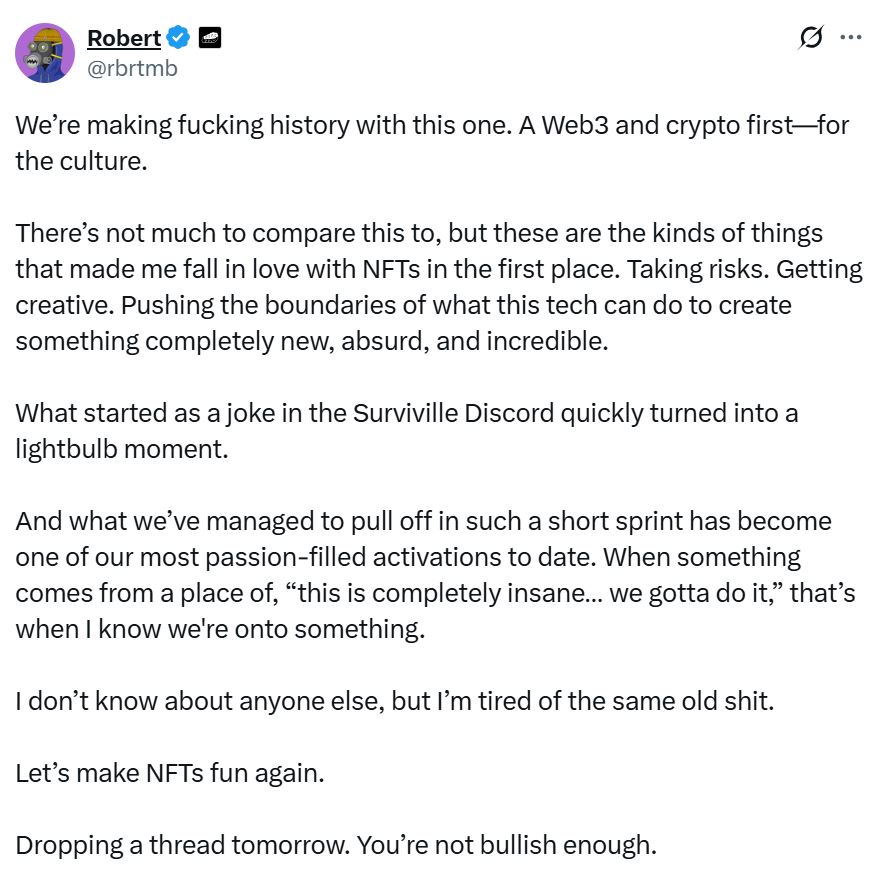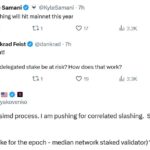In an intriguing marriage of technology and whimsy, a Solana-based NFT project dubbed “Dead Bruv” is setting its sights on acquiring a Cold War-era nuclear bunker located in Rutland, England. The ambitious plan involves minting 100,000 non-fungible tokens (NFTs), with a starting price of $14 each, to raise funds for the bunker, which is listed for about £650,000 (approximately $862,257). As noted on the project’s Meatbags account, holders of existing Meatbags NFTs will also receive an airdrop of 10,000 tokens.
Once the purchase is finalized, NFT holders will gain exclusive entry into a decentralized autonomous organization (DAO) called the Billionaire Bunker Club. This community-driven entity will have a say in the bunker’s future, potentially shaping it into a survival resort or a quirky location for end-of-the-world festivities. The bunker, which was built in 1960 as a monitoring post during the Cold War, sits on a generous 1.4 acres and comes with permissions to transform it into a habitable space.
“When something comes from a place of, this is completely insane, we gotta do it, that’s when I know we’re onto something,” said Robert, a co-founder of Dead Bruv, highlighting the project’s unique blend of humor and creativity.
The auction for the bunker is set for April 24, just days after the NFT sale launches. This venture draws parallels to previous crowdfunding initiatives like ConstitutionDAO, which sought to buy a copy of the U.S. Constitution but fell short in its efforts. Meanwhile, LinksDAO successfully purchased a golf club in Scotland, showcasing the growing trend of DAOs acquiring real-world assets through community-powered funding.
As this doomsday-themed NFT endeavor unfolds, it reflects a broader movement within the cryptocurrency and blockchain community, where innovative ideas are frequently pushed to engage digital enthusiasts in unexpected ways. Whether or not Dead Bruv’s audacious plan succeeds, it undoubtedly adds a whimsical chapter to the ever-evolving narrative of NFTs and decentralized governance.
Doomsday-Themed NFT Project to Buy Cold War Nuclear Bunker
This article discusses an innovative NFT initiative by Dead Bruv, aiming to purchase a historical Cold War-era bunker in Rutland, England, through the sale of NFTs. Here are the key points regarding its implications and impact:
- Sale of 100,000 NFTs
- Price set at $14 each, beginning April 21.
- 10,000 NFTs will be airdropped to current holders of the Meatbags NFT.
- DAO Membership
- Holders of these NFTs will join the Billionaire Bunker Club DAO.
- This organization will govern decisions related to the bunker if purchased.
- Potential Uses of the Bunker
- Concepts include a survival resort, end-of-the-world festivals, or luxury Airbnb experiences.
- Historical Significance
- The bunker has a Cold War history, built for nuclear monitoring and decommissioned since 1968.
- Located on 1.4 acres, it may have potential for unique real estate applications.
- Innovation in NFTs
- Project co-founder aims to make NFTs “fun again” through creative and absurd concepts.
- This emphasizes the evolving nature of NFTs and their applications beyond traditional art or collectibles.
- Crowdfunding via DAOs
- Similar to ConstitutionDAO’s attempt to purchase the U.S. Constitution.
- Demonstrates the growing trend of crowdfunding for high-value items using blockchain technology.
“When something comes from a place of, this is completely insane, we gotta do it, that’s when I know we’re onto something.” – Robert, Co-founder of Dead Bruv
Doomsday Dreams: An Innovative NFT Venture or a Risky Investment?
The recent initiative by the NFT project, Dead Bruv, to sell 100,000 non-fungible tokens (NFTs) aimed at purchasing a Cold War-era nuclear bunker illustrates a unique convergence of digital art and tangible real estate ownership. In a landscape where conventional NFT projects often focus on artwork or in-game assets, this venture attempts to capitalize on a whimsical yet practical concept—creating a community-governed real-world asset.
Competitive Advantages: The project’s concept stands out for its creativity and humor, attracting attention from both the NFT community and the mainstream audience. By engaging holders through a decentralized autonomous organization (DAO), which allows members to vote on future uses of the property, the project fosters community involvement and a sense of ownership. This approach echoes successful projects like ConstitutionDAO, which galvanized public interest for community-funded purchases of high-value items, albeit with mixed results.
Disadvantages: However, the Dead Bruv project also faces notable challenges. The ambitious nature of converting a Cold War bunker into a casual venue or resort could come off as impractical. Past crowdfunding efforts, such as the ConstitutionDAO, illustrate the hurdles of raising sufficient funds, especially considering the high selling price of the bunker and additional costs associated with transforming the property. Furthermore, given the tumultuous market for NFTs—evidenced by a significant drop in sales in the first quarter of the year—this speculative nature may deter potential investors wary of participating in a venture that treads the line between absurdity and feasibility.
This project could notably benefit enthusiasts looking for novel investments that blend humor with tangible outcomes. Additionally, community members keen on offbeat experiences, such as themed festivals or unique vacation stays, might find appeal in the potential of the bunker becoming a members-only resort. On the flip side, detractors may argue that such a project could open the door to financial loss, particularly if the market for NFTs continues to decline, or if local regulations hamper the transformation of the bunker.
In a rapidly evolving environment where NFTs are struggling to maintain their initial glamour, Dead Bruv’s attempt to make them “fun again” presents both an exciting opportunity and a cautionary tale in navigating the evolving landscape of digital ownership.

















